Cooped up alone during quarantine? Consider a bacterial companion. With just a few household ingredients and a little time, you too can give birth to a a jiggly, wiggly vinegar mother you can take out of the jar and play with during isolation, or...eat if things take a turn for the worst. Either way you'll have a good compliment to the boiled cabbage we'll all be eating once the food supply chain breaks down.
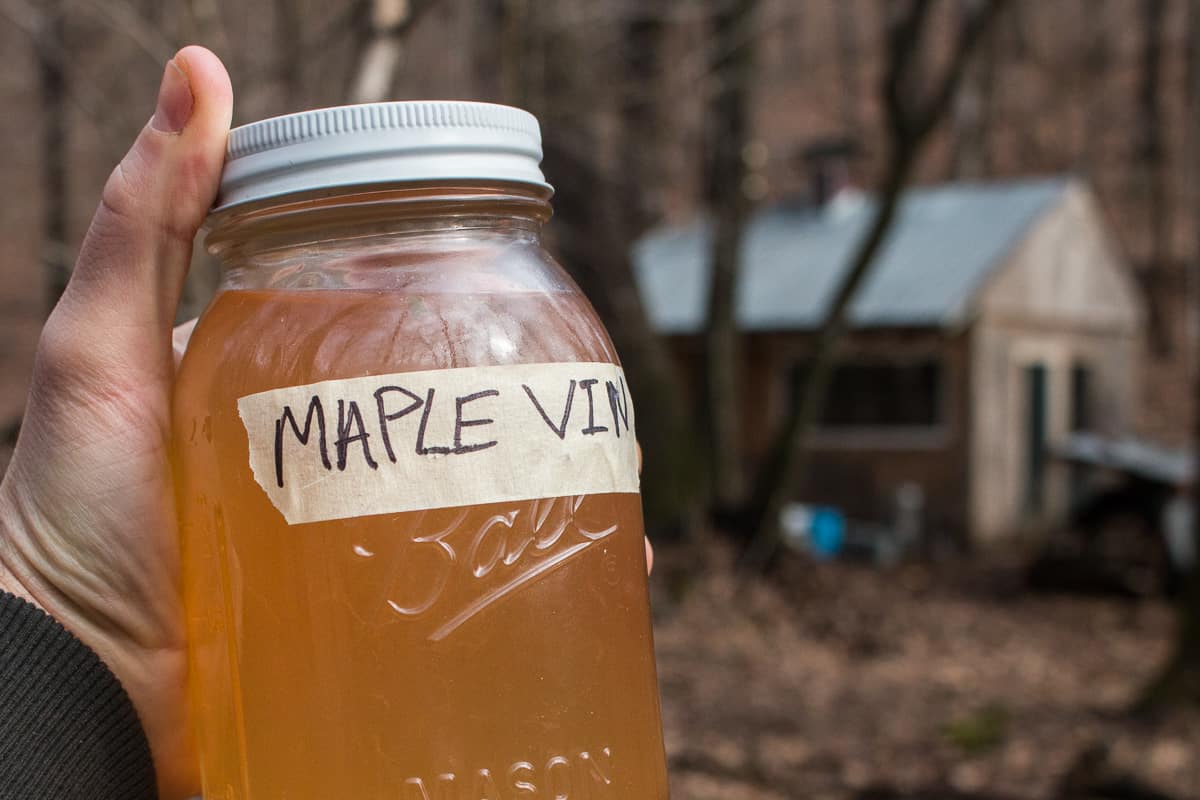
In all seriousness, vinegar is one of the human culinary constants: just about every corner of the world has their specialty. There's Chinese black vinegar, Italian tomato vinegar, and the famous French banyuls and other vinegars made from rare wines. Move down to Africa and you'll probably see malt vinegars made from beer, hop across the pond to Costa Rica and South America, and you'll see vendors on the street with bottles of pure white coconut vinegar. Travel up to North America and, of course you'll find apple cider vinegar, but another, and possibly even older one, is maple vinegar.
Indigenous people of North America knew of maple vinegar, and it's use is pretty well documented in culinary ethnobotany texts that I have (especially Native American Foodplants by Daniel E. Moerman). Just like wine vinegar, some lucky person left some reduced sap out, or maple some partly reduced sap, accidentally let it to ferment to alcohol (or what you'd probably call acerglyn/maple mead) and from there, it eventually turned to vinegar.
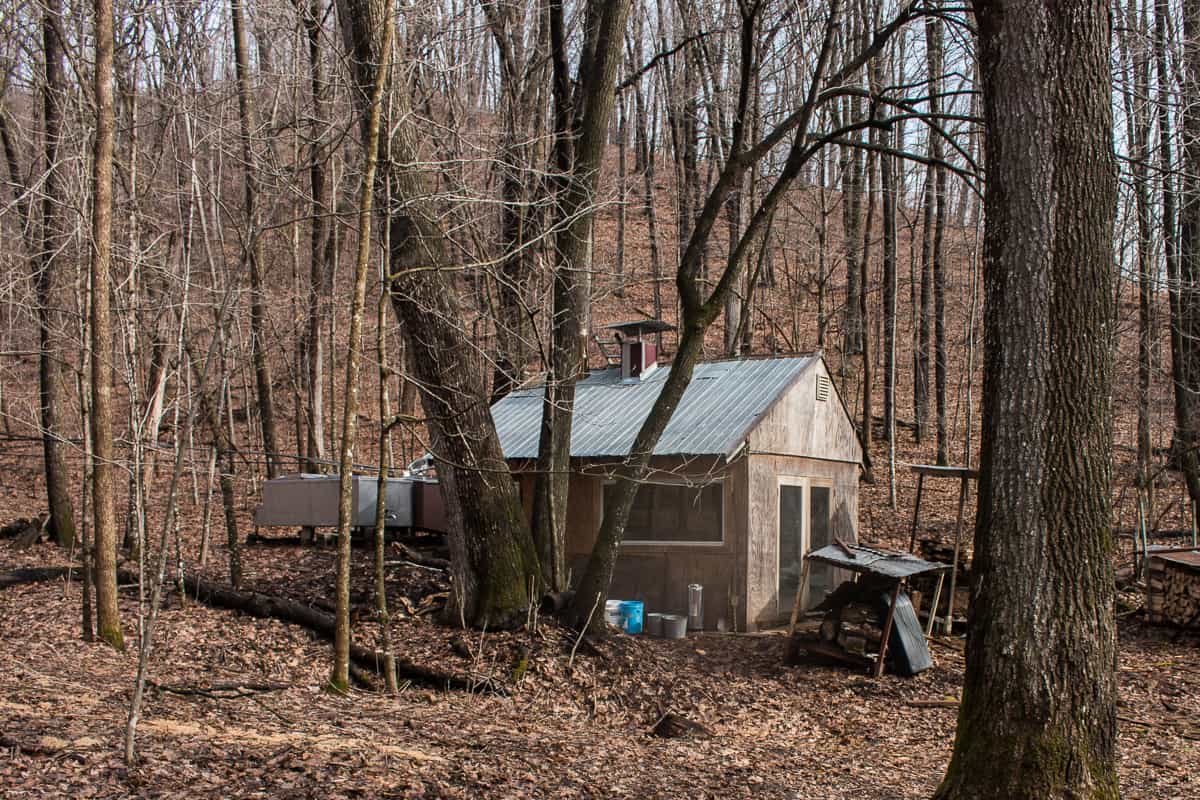
Up until a few years ago, I'd never heard of maple vinegar--not a whisper. There's no fancy food suppliers I know of that sell the stuff, and you're not going to find it at a grocery store. I learned about it in passing from speaking to local author Beth Dooley, when she told me about a book she was working on with our mutual friend, photographer / author Mette Neilsen called Sweet Nature--all about cooking with honey and maple syrup. Look online though, and you won't see much, except one recipe for maple vinegar from the well known Aki Kamozawa and H. Alexander Talbot from the popular website of Ideas In Food, and one or two suppliers of the real deal.
Now, unless you're tapping your own trees and reducing your own sap, maple syrup is expensive, and the recipe I referenced above is going to set you back a whopping 3 cups of syrup--probably not a big deal if you're cooking your own. But, without a lot of maple syrup to experiment with myself, I wanted to use something with cheap, plentiful maple sap. I wanted a maple sap vinegar hack--a thrifty shortcut.
Sidenote: if you want to skip all the fun and purchase maple vinegar, read the ingredients and processes carefully in the description. The devil's in the details. You want pure, fermented maple sap, not an infusion, extract, or other b.s. like wine vinegar with maple flavoring, etc.
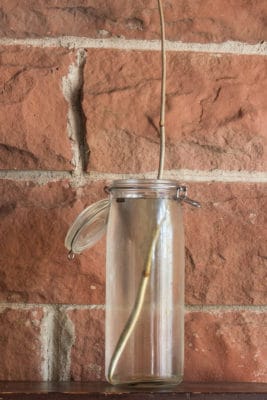
Now, most of the accounts I've read of maple vinegar describe it as "fermented sap" or similar, which might bring to mind a jar of white vinegar. But, you need to read into it a bit. Pure sap, which is white and clear, is basically water. In order to get a good sugar content, which leads to a high alcohol content, which in turn transforms to a solid acetic acid content, the sap needs to be reduced, which darkens the color, bringing us back to maple syrup.
You might be wondering if you can just ferment pure maple sap, and, of course you can, the version in the tall jar is one using only sap and white sugar, in an attempt to get a clear vinegar like the vinagre de coco from South America. Unfortunately sap by itself, especially with white sugar to keep it clear doesn't taste like anything, and, the fact remains: why use white sugar when you could use maple? It's just more interesting. With all of that in mind, I set out to build a little hybrid maple vinegar recipe that I could use, doing a few experiments loosely based on some of my reading in Rene Redzepi's The Noma Guide to Fermentation, with the following goals:
- Use as much sap (or water) as possible
- Use as little maple syrup as possible
- End up with a product that still has a good bite and decent flavor
- It should fit in a quart jar, since I have a bunch
I took 3 different jars, mixed up a couple solutions (1 cup, ¾ cup, and ¼ cup ratios of maple syrup in a quart jar) waited, and took notes. Jars with more maple syrup took longer to have their sugars digested, and the jar with the smallest amount of maple had the most vigorous fermentation, and fastest turn around. All of the concentrations there will work, but the cheap maple-sap-vinegar-hybrid is a fun, thrifty kitchen hack, so that's the one I'm sharing.
The Secret: Booze and Bacteria
The secret is a team effort of science and bacteria: adding some living vinegar (preferably homemade) functions as an inoculate, and adding alcohol jump starts the alcohol by volume (ABV) to ensure a decent amount of acetic acid (sourness) in the finished product. Is it as traditional as fermenting straight maple syrup to vinegar? No. Will it make decent tasting vinegar in a few weeks for next to nothing? You bet.
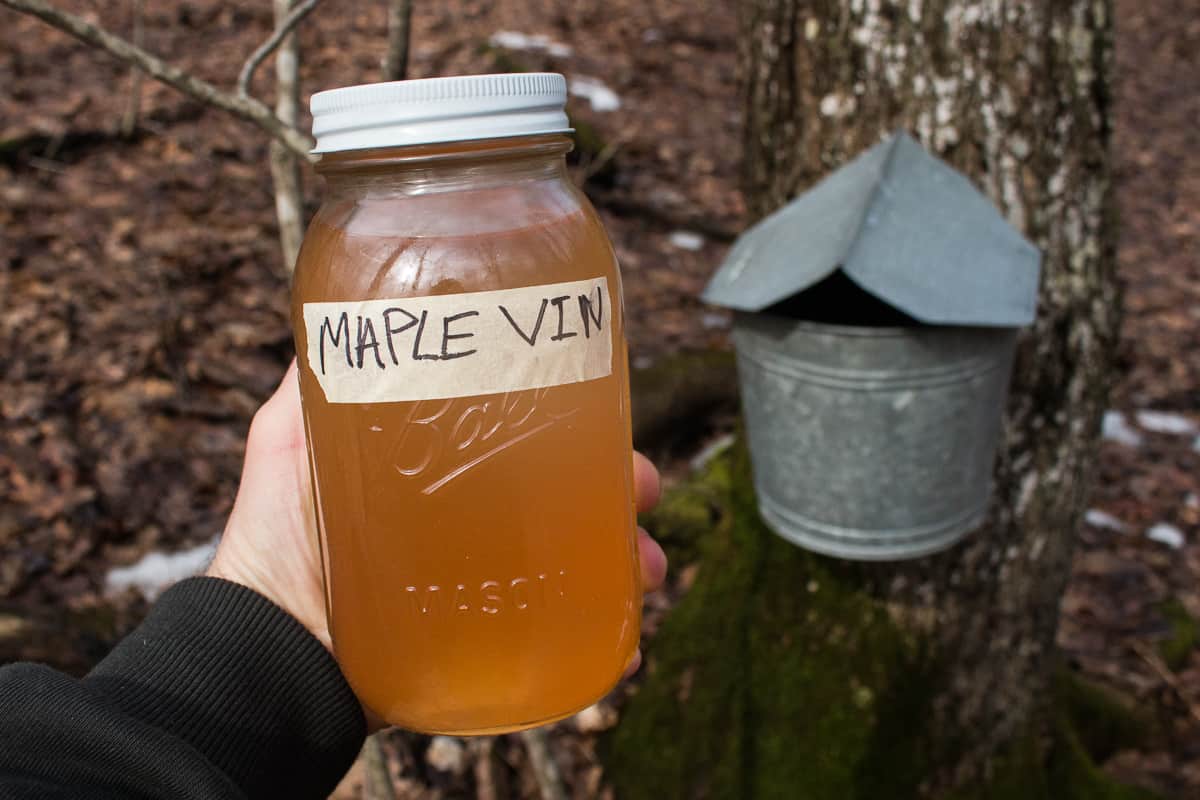
Maple Sap Vinegar
Equipment
- Quart mason jar
Ingredients
- 120 grams (½ cup) 80 proof vodka or equivalent
- 60 grams (¼ cup) raw apple cider vinegar "with the mother" or homemade vinegar
- 700 grams (3 cups) maple sap
- 80 grams (¼ cup) maple syrup
Instructions
- Combine all ingredients and mix well, then place in a quart mason jar with a cloth tied around the top and ferment at room temperature.
- After a few weeks, you'll notice a mother forming inside the bottle like a flubbery jellyfish.
- Continue tasting the vinegar from time to time until it tastes good and acidic to you--a few weeks to a month, then put a lid on the jar and store in a pantry.
Notes
It's Alive
As long as the vinegar isn't heated enough to kill the ferment, it can be used to start other vinegars.Don't Skip the Booze
The alcohol is part of the magic here, helping to jump start the ABV to ensure a tart end product in the shortest period of time.

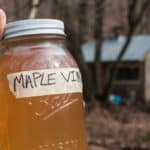
Mike
Hi Alan - My brother has been doing maple syrup for a while and I like to ferment things. He recently gave me about a gallon of partially boiled sap - it's currently frozen and he said he reduced the sap by about half and thinks the sugar content would be about 10-15% at the most. Is that enough to ferment on its own (i.e., without adding additional alcohol)? Thanks much!
Alan Bergo
Hey Mike, off-hand IDK if it would work without adding the alcohol, but you could try. If you don't see vigorous fermentation after a week I'd add some alcohol. LMK how it works for you if you try.
Joe
Worked out great for me. I've been using it to season coleslaw.
Mike
Hi Alan -
An update for you. I split the sap into two batches. The first more-or-less followed your recipe above, which worked great! For the remaining sap, I fermented it into maple mead or acerglyn (ABV was ≈ 5%). I used the mother from the first batch of vinegar to covert a quart of the acerglyn into vinegar. Both versions are vinegar. I don't notice a strong maple flavor in either, but the acerglyn vinegar has a more complex flavor profile.
Alan Bergo
Thanks for sharing Mike.
Robin
I think you need the alcohol the actabacter/mother converts the ethanol to acetic acid you would have to convert the sugars to alcohol with a yeast first.
Alan Bergo
Thanks Robin.
Gail
Would the apple cider vinegar sold at the grocery store work? Otherwise, where could I get raw apple cider vinegar? What makes it "raw"?
Alan Bergo
You want something like “Bragg’s Apple Cider Vinegar with the Mother”. Raw means it hasn’t been pasteurized which kills the bacteria.
Jasmin McBeth
I have made your recipe but am not clear on the directions, do I stop stirring after one week? When do I remove the cloth and move to a lid?
Alan Bergo
Hey Jasmin, you'll put a lid on when it tastes like vinegar. Stirring is not a big deal-everything should work on its own. I'm here if you have follow up questions.
Dj
Hi Jasmine, we have been making maple sap vinegar from our sugaring operation for a few years. This year we made two 5 gallon pails of it and the mother got a fungus of some sort around it. We skimmed it off and the rest of the vinegar looks fine, but we had let it go all summer as we were building a new house. Do you think this is still good? It seems fine?
Alan Bergo
If it tastes sour like vinegar you’re fine.
Dj
Thanks Alan, sorry I had the wrong name on that reply
Tanya
Hello! I followed the recipe with maple sap I tapped on my property. I started the process on 6.25.2022. I got a little ring of “mother” around the rim, but that’s it. I’ve tasted it a few times over the course and it kind of tastes sour…but not in a good way? I’m not sure if I messed something up, if it’s safe to eat or maybe I just don’t like maple vinegar. Which would shock me because I love all vinegar. Wasn’t sure if you could provide feedback or advice. Thanks so much!
Alan Bergo
Hi Tanya, so, I would make sure you followed the method as directed, this has been tested by myself and a bunch of other people. A "ring" of mother sounds like it could be Kahm yeast to me. As long as the liquid is allowed to respire there should be no issues. If you really like making homemade vinegar, you might try my fruit scrap vinegar.
Keri
Hi! Thank you for this...I have a lovely little cup and a half of maple sap (tree branch cutting, but didn't think of collecting the sap at first as it was a bit distressing to see the tree like that), so i am halving your recipe.
Question: do you leave the "rubbery jelly fish" substance in the jar or do you remove it?
Thank you so much.
...Keri...
Alan Bergo
The rubbery jellyfish is the mother. If it's in the finished jar, it's a good thing, you can discard it when it's finished, or use it to start more vinegar.
Allison K Schmitt.
Hello Alan:
Does any of the alcohol remain as alcohol? Or is it all converted into vinegar? I want to sell this under Minnesota cottage food laws, but the finished product can be only half a percent alcohol. Testing is spendy!
Thanks!
Alan Bergo
All of the alcohol is digested into vinegar.
Tammy Burns
Greetings Alan. I have a batch of the vinegar on the go now. I used vodka in one batch and used gin in the other. There is a discernible difference in the odour of each batch for sure This is the first year that my son has tapped trees on his property in Lanark County. I am a big fan! Thanks for the inspiration!
Alan Bergo
Hey Tammy, Thank you. Yes the gin will have a stronger flavor, at the end of the day it's not a big deal-it's just vinegar.
Judy Krohn
Thanks for this recipe/method. The trees are dripping slowly in our woods, and I'm definitely going to give this a try!
Alan Bergo
Thanks Judy. We've been dumping buckets the whole week over here at BSF.
Deborah Aaron
Thanks ! We tap our own trees -- i am going to try this. From thread above, you can make the maple vinegar without using alcohol? If you use alcohol, does it remain in vinegar?
Alan Bergo
There is no alcohol left in the vinegar after fermentation, as the alcohol is what help feed the ascetic acid.
Cheryl Babineau
I wonder if you could substitute coconut water for the sap. For an interesting marriage of flavours...
Alan Bergo
After testing different proportions of this with both sap and water over the last year, I’d say that you definitely could. Don’t expect it to taste like coconut-maple though. Fermentation into vinegar denatures flavors, and mild ones especially will be hard to pick out of the finished product.
Cheryl Babineau
Thank you Allan...
Gary Makus
Can I substitute Birch sap for maple sap?? - (which I have a lot of)
Alan Bergo
I assume you'd be able to. But. Keep in mind this is a quick hybrid recipe for people that might not have access to sap or alot of syrup. If you have the ability, I would use the following proportions:
1 cup birch syrup
2 cups water
1/2 cup everclear
1/2 cup living vinegar
It will take longer, but you'll get a richer vinegar.
William Hunter Duncan
I tapped the Boulevard maples next to my garden in minneapolis, and the ferment was like citrusy champagne. I might have an old bottle that didn't ferment prporerly, so i will think about vinegar. Thanks!
Alan Bergo
Hope you're doing well in your part of the world my man.
Matt
If you can’t get the sap, how much extra syrup should one add to equal the sap content ?
Thanks!
Alan Bergo
Hey Matt. It's easy. Just substitute filtered water. The alcohol and the maple syrup are the key components here. It's more of a vinegar made from maple syrup. It can be made without sap. Mostly it's used here as an excuse to use the sap in something. It's a good teaching example that invites people to experiment, celebrate the season and get outside. The sugar content is negligeable in the amount in the recipe. One thing it does add, although it's hard to quantify, is natural yeast.
Jay
Been making this for a few seasons now with great results, so thanks! But this year, in one fermentation vessel was a tiny bloom of mold on top of the mother. In my 2nd vessel was a large bloom covering the whole top of the mother. Neither one is Kahlm btw. Both are sweeter than normal, the moldier one is too sweet. Any troubleshooting suggestions? I'm thinking just draw off 75% of the 1st batch and add a bit more acv to the first one at bottling, then just ditch the moldy ass one. ?? Can I try referermenting since the mold was above the mother and potentially sealed off?
Alan Bergo
Hi Jay, this sounds like a contamination issue. Make sure the jars are clean. If there's mold in the jar everything should be tossed and sterilized.
Carla Beaudet
Interesting. I've been making maple mead from the leavings of a friend's maple operation (the stuff in the pan that never quite made it to syrup - there's usually about 4 gallons) for several years now. I guess if a batch of the mead ever turns out nasty, I could let it go over into vinegar. That's what I do with cider which doesn't turn out great. But I've never tapped the trees myself (and not for lack of sugar maples on the property), and your recipe might give me a good excuse to do that next Spring. As always, thanks for the inspiration!
Kathy
We are making syrup for the first time this year, I’m confused about what the leaving are.
Tom Hirth
Thanks Alan! Small mistake though—The Art of Fermentation was written by Sandor Katz. I’m looking forward to trying this!
Alan Bergo
Thanks Tom, I was referring to the Noma Guide to Fermentation, you're right.
Amy Stein
Hello Alan we are maple syrup producers and I make apple cider vinegar every fall. I have plenty of mother of vinegar. If I want to make and bottle maple apple cider how do I stop the end product from developing more mother?
Alan Bergo
Hi Amy, can you explain to me what you mean by "maple apple cider"?. Heating vinegar will kill the ferment and sterilize it.